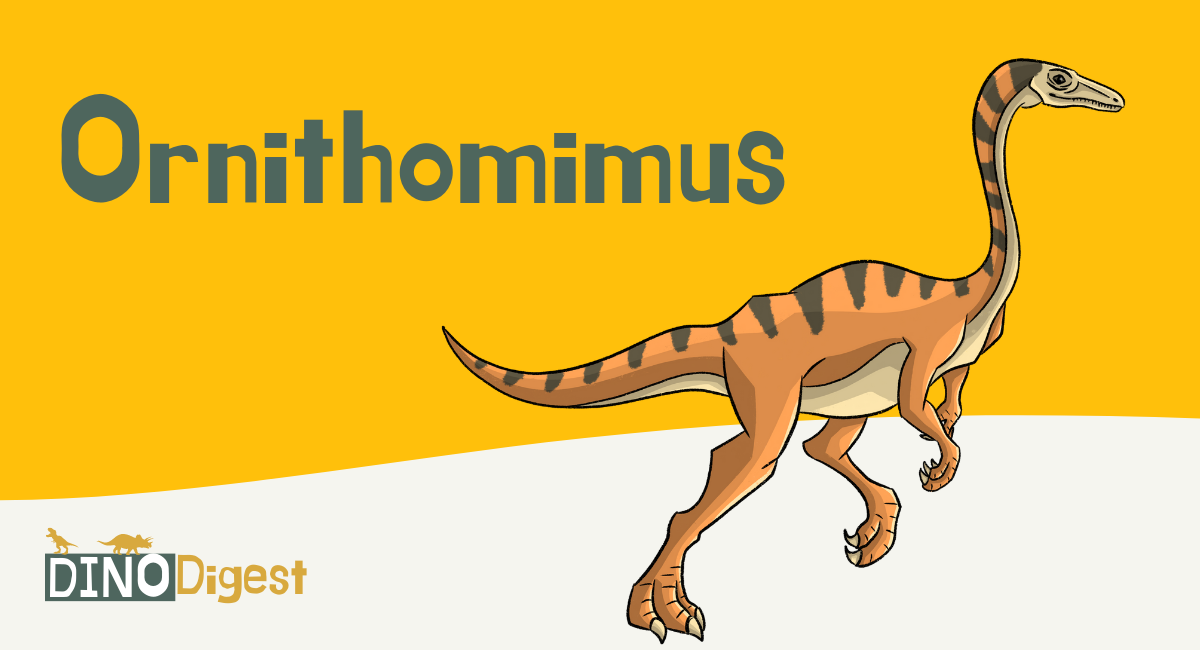The Ornithomimus was a bird-like dinosaur with feathers and ornamental wings it used for display. Before this new species was discovered in 1889, no one had ever considered that birds could be descendants of dinosaurs. Modern birds did not descend from Ornithomimid dinosaurs, but the discovery of these feathered dinosaurs led to many more exciting advances in paleontology.
Table of Contents
Some Quick Facts about the Ornithomimus

| Name | Ornithomimus (meaning “Bird Mimic”) |
| Type of dinosaur | Theropoda/Saurischia Dinosauria |
| Territory | Swamps and forests of North America |
| Size | Medium-sized, 11.5-15 feet long, 6-7 feet tall, weighted 375-500 pounds |
| Color | Bluish, with scales and feathers |
| Interesting Characteristics | Ostrich-like feet, short forelimbs with wings. Had large eyes and a long tail |
| Diet | Omnivore |
| Major Threats | Carnivorous dinosaurs, natural disasters, and climate change |
The Ornithomimus was a toothless feathered dinosaur with a small head and a very large brain, similar to Pisanosaurus. But the Ornithomimus was quicker than it was smart. Its large brain was used to help the Ornithomimus stay coordinated as it ran up to 43 miles per hour just like an ostrich!
What Did the Ornithomimus Eat?
There is a lot of debate over what Ornithomimus ate. Most theropods were meat-eaters, but other Ornithomimid dinosaurs were omnivores. Based on fossil evidence, Ornithomimus had gastroliths in its stomach. Gastroliths are rocks swallowed by plant-eating dinosaurs to help with digestion.
There is also evidence that the Ornithomimus ate bugs and small animals. Its sloth-like hands and claws were used to grip its food, which was crushed in its toothless beak. The inside of the Ornithomimus’ mouth was ridged like the inside of a duck’s mouth. Based on what paleontologists know so far, the Ornithomimus was an opportunistic feeder that ate whatever was available.
Ornithomimus speed: how fast was this dino?
Ornithomimus was running at around 40 miles per hour. This was its top speed.
Did Ornithomimus lay eggs?
Scientists only presume that Ornithomimus laid eggs. They still haven’t discovered any eggs or eggshell fragments around the fossils to be sure.
Where Was the Ornithomimus Found?
The two species of Ornithomimus were found separately in America and Canada. O. edmontonicus was the only species of Ornithomimus found in Alberta’s Dinosaur Park Formation (Sternberg 1926). O. velox was first found in the Denver Formation in 1889 by Othniel Charles Marsh. The Ornithomimuses from Arizona, Colorado and Montana are all O. velox.
A dinosaur like the Orithomimus was found in Mongolia in the 1930s. Originally this dino was given the name Ornithomimus asiaticus. In 1972, paleontologist Dale Russel examined the Mongolian fossil and determined it was a different Ornithomimid. He gave this dinosaur a new genera Archaeornithomimus, which means “ancient bird mimic.”
Fun fact, Ornithomimus’s closest relative was actually another Ornithomimid found in Mongolia called Gallimimus. The Gallimimus was also feathered and grew wings as an adult to attract mates and scare off predators. Even though Gallimimus means “chicken mimic”, the Gallimimus was actually the largest of the Ornithomimid dinosaurs.
What Dinosaurs Did the Ornithomimus Live With?

The Ornithomimus edmontonicus lived with fellow Ornithomimids the Struthiomimus and Dromiceiomimus in Alberta, Canada. The Centrosaurus and Edmontosaurus also lived in Alberta when Ornithomimus edmontonicus was alive. These plant-eaters would’ve stayed close to each other for safety against predators.
Both species of Ornithomimus lived side by side with small carnivores called Troodons who ate small lizards, mammals, and insects. The Ankylosaurus, Parasaurolophus, Pachycephalosaurus, Styracosaurus, and Triceratops lived near the Ornithomimus, too. The T. rex and Albertosaurus ruled the region where the Ornithomimus lived, and they often preyed on Ornithomimuses.
The Ornithomimus used to be depicted with scales and featherless. Thank to fossil evidence found in 2015 by paleontologists Aaron van der Reest, Alex Wolfe, and Phil Currie, we now know that Ornithomimus was a feathered dinosaur with bluish skin. Despite its close relative the Gallimimus being called the “chicken mimic”, modern birds like chickens are actually closer cousins to the T. rex than a Ornithomimus!

